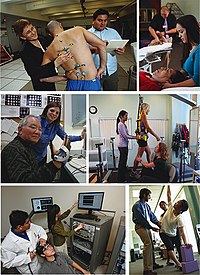
Photo from wikipedia
AIM To identify determinants of physical, mental, and emotional nursing workload. BACKGROUND Workload has a physical, mental and emotional dimension. It influences employees' wellbeing and quality of care. Nevertheless, studies… Click to show full abstract
AIM To identify determinants of physical, mental, and emotional nursing workload. BACKGROUND Workload has a physical, mental and emotional dimension. It influences employees' wellbeing and quality of care. Nevertheless, studies of specific predictors for each dimension of nurses' workload are scarce. METHODS We used a cross-sectional prospective design based on the Job Demand-Resources theory. We asked nurses to describe workload perceived at the end of every shift over three consecutive weeks. Data were gathered from two academic hospitals, in seven medical-surgical wards. We received 259 responses and tested two multivariate regression models. RESULTS Physical workload was predicted from all variables tested, mental workload was determined by patient complexity or isolation, adequacy of nurse staffing and skillmix, and unscheduled activities; emotional workload was predicted by all variables except adequacy of staffing and other people's education. CONCLUSIONS Patient, nurse and workflow aspects influenced nurse's shift workload differently for each specific dimension. IMPLICATIONS FOR NURSING MANAGEMENT Measurement and definition of predictors of workload in the work environment are essential. Recognizing the determinants of specific dimensions of workload facilitates identification of the most appropriate interventions to improve nurses' wellbeing in healthcare settings.
Journal Title: Journal of nursing management
Year Published: 2022
Link to full text (if available)
Share on Social Media: Sign Up to like & get
recommendations!